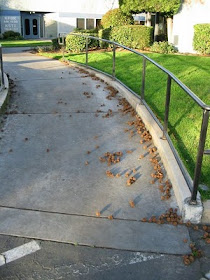
If you are tiptoeing around the sharp, spiky seedpods of liquidambar (sweet gum) trees throughout the year, now is the time to control their development.
Peering into your liquidambar tree in early spring...
look for this rather unremarkable flower:
If you see those, it's the time to spray a product containing the growth regulator, Ethephon. One such product is Monterey Lawn & Garden Products' Florel. Thoroughly sprayed onto the blooms of an ornamental tree that produces undesirable fruit, the chemical causes the blossoms to abort, stopping fruit production. In the case of the liquidambar tree, the fruit are those sharp seedpods that are the bane of barefooters everywhere.
According to Monterey, "the best time to spray Florel is when the flowering plant is in the mid to full bloom stage. The ideal time for spraying sweet gum (liquidambar) is right after the tiny balls form below the catkin. After application, these tiny balls simply dry up and fall off."
According to the product label, Florel will also control undesirable fruit on other ornamental plants such as Buckeye, Crabapple, Carob, Cottonwood, Elm, Flowering pear, Horsechestnut, Maple, Oak, Olive, Pine, Sour orange and Sycamore trees.
A few notes about applying this growth regulator:
• Read and follow all label directions.
• Timing is critical. There is a short window of opportunity to spray while the blossoms are in mid to full bloom.
• Thorough coverage is necessary. Monterey suggests it takes about 5 to 20 gallons of the Florel and water mixed together to coat the flowers of a tree, up to the point of runoff. One quart of Florel makes about 10 gallons of mix.
• The product works best when applied during daytime temperatures of 65-90 degrees.
• Use the mixed product immediately. When first combined, the mix has a very acid pH of 2.5; but that acidity decreases as the mix hydrolizes, reducing its effectiveness.
• And how do you reach those blossoms that are out of the reach of your sprayer? That's when it's time to call in the arborist with a crane.




Another growth regulator, Atrimmec, is currently being tested for liquidambar seedball control. Available at this time in California for professional pesticide applicators only, the results are promising, but not yet conclusive. Liquidambar is not yet listed on the product label: http://www.cdms.net/LDat/ld60B005.pdf
ReplyDeleteThe manufacturer is working on getting state approval for homeowner use of this product.
Any update on this additional product to stop the spiky balls?
DeleteAttmmec is a hoax IMHO. I'm a licensed plant care applicator in California. 1. Timing is very difficult as budding varies from tree to tree and limb from limb. 2. Can not get enough product on stem as directed. The tree become saturated and you still have lots of product to go to achieve results . I tried it on two of my three liquid Ambertree and tried it on a neighbors tree . It's a shame but I cannot legitimately sell this product as a service for fruit control on liquid Amber . I was hoping to make a lot of money 😭.
DeleteWhen I had a sweetgum, I tolerated the seedballs. It was fascinating when tiny birds arrived to eat the seeds. I'd have those seedballs swept of that drive in less than five minutes.
ReplyDeleteI can't imagine spraying to stop a natural process. What does it do to nearby plants? Why not just cut down offending trees?
You obviously do not have a large tree. Ours is a nightmare--I believe it is about 70 years old. I wish there were a systemic solution--ours is too tall to spray.
DeleteStop a natural process?
ReplyDeleteYou mean like taking medicine to prevent high blood pressure?
Like building an airplane to unnaturally fly people around the world?
Like wearing a condom to prevent pregnancy?
You're right, we should just cut it off/down next time...
Insect netting around the bottom of the tree angled to dump into a wheelie bin does the job for me with my 80 year old sweet gum. I didn't have the heart to cut it down, although it's nearly five foot thick at the base so it would be a hell of a job. But those balls were the bane of my gardening for far, far too long so I decided to figure out a way to deal with it. The seed pods fall off and slide down the meshing (it's like a stocking material, sold as insect proofing at my local hardware store, I forget the brand name) and into the bin. An occasional blockage might need a poke with a painters extension handle of appropriate length, but it's no big because you're catching them all at the base of the tree. Give it a week after you stop seeing collection in the bin just in case, then the rest of the year you're home free!
ReplyDelete